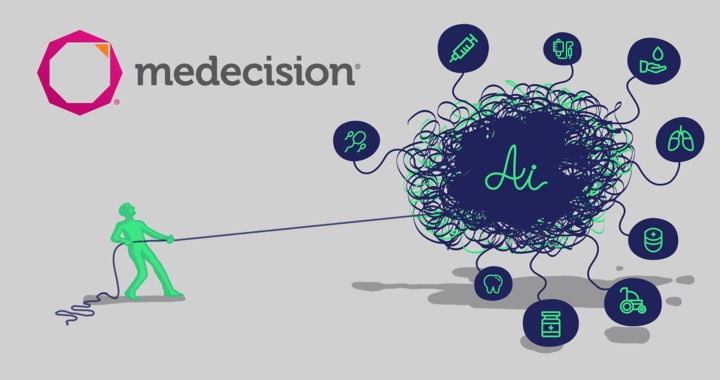
5 Takeaways from the HLTH-Medecision Webinar on Transforming Data into a Strategic Asset for Person-Centric Care
As healthcare witnesses unprecedented advancements in data, AI, and large language models, it’s incredibly important that executives at this brink of technological revolution ask: are we prioritizing the right data for truly person-centric care, or are we losing focus amidst the surge of information and AI-related developments? With healthcare at the forefront of data production – more than 30% of the world’s data comes from healthcare [1] – how should organizations be taking advantage of their data? How can we utilize this information to create a better world for care and care teams?
Facing an AI-powered future means this is a critical time to reassess current practices and assumptions around data utilization. Leaders need to prioritize responsible and ethical use of that information and refine approaches to ensure organizations focus on the right data. Achieving that will require leaders to outline tangible steps toward more person-centric models of care based on relevant data and to reorient the current focus from systems to human beings.
“If you don’t have the quality data as you apply new AI models, if you don’t have all the data sets necessary, you’re not going to get the benefit… [but will] add additional costs to the system without the appropriate outcomes being derived from the AI,” said Kenneth Young, CEO, Medecision.
Young recently participated in a HLTH webinar, “AI Chaos to Clarity: Transforming Data into a Strategic Asset for Person-Centric Care,” with Kim Victory, Healthcare Director at Google, that was moderated by Dan D’Orazio, CEO, Sage Growth Partners. The conversation explored crucial questions about the responsible use of data in the era of AI-powered healthcare. Here are five key takeaways from the insightful discussion.
1. The Landscape of Healthcare Data is Overwhelming:
D’Orazio explained that big data could transform the healthcare sector, but the industry must undergo fundamental changes before stakeholders can capture its full value.
From 2013 to 2020, the amount of data generated in healthcare grew by 47% annually.[2] There is a staggering volume of data created within even a single hospital, with 137 terabytes generated by providers daily.[3] The industry faces challenges of unstructured and disorganized data, compounded by the 1,500 healthcare AI vendors, more than half of which were founded in the last 7 years.[4]
“With the proliferation of data, the question becomes how do we make it useful for person-centered care in a workflow, in a language that people understand for both the patient, the clinician, and all the other folks that need to impact that level of using that data,” D’Orazio asked.
The first step toward person-centric care is addressing interoperability issues and ensuring AI isn’t built on messy data.
“For healthcare in general, it’s going to be harder to get to interoperability than other retail or financial services because of the…older systems that a lot of organizations have,” Victory said.
While the issues of diverse data formats, fragmented systems and standards, and privacy concerns are not new, neither are the systems on which many organizations base their day to day workflows. Rather than being able to solve this problem overnight, many organizations are now turning to “AI solutions” before addressing their most critical business needs. Victory recommended identifying the most critical area, and solving that data problem first, and then surrounding that with other forms of data to better propel patient care and experience.
2. Prioritizing the Right Data is Critical:
“We are really focused first and foremost on that data, and taking learnings from other industries, like financial services or retail or IOT, about how to interpret data in a way to create that ecosystem for individualized use cases,” Young said. “Where healthcare is going to make an impact is with specific use cases for person-centered care and that starts with solving that data quality issue and interoperability.”
The central question raised during the webinar was whether the healthcare industry is prioritizing the right data for person-centric care amid the information and AI surge. Leaders must reassess their approaches to data utilization, emphasizing responsible and ethical use. The focus should shift from systems to human beings, requiring tangible steps to build models based on relevant data.
3. Setting the Stage for Person-Centric Care Requires Context:
“You have to provide the contextual awareness to know where that person is in their journey, whether they’re coming off of a real-time event, like a discharge from a hospital, or you are doing claims-based analytics, or other analytics that you’re running against a dataset …. All of these have to come together into that data interoperability perspective and provide the contextual awareness so that the AI can actually create the right action to direct the right care.”
Healthcare executives need to strive to not lose focus amidst AI-related developments. That means leaders must reassess current practices and assumptions to prioritize responsible and ethical data use. Only by doing so, will they be able to get the right care to the right people at the right time.
4. Financial Considerations and Real-World Examples:
“You can’t stop your business to spend a year to plan what you’re going to do. You’re going to have to solve business problems right now even though everyone is in cost cutting mode,” Victory said.
Addressing financial concerns, the discussion delved into the ROI of future solutions compared to existing practices. At the same time most organizations are prioritizing patient care, they are also looking at the way they are going to build a solid data enterprise. While AI is able to provide insights, organizations must make the analysis of prioritizing technological and data considerations – while also demonstrating the ways these will impact patient care right now and in the future.
“Health plans are taking a two-tiered approach. One is looking at the administrative savings you can get by leveraging AI […] and number two is where they’re going slightly slower, and going slower is appropriate, is figuring out where they can impact patient outcomes and patient care.”
Young also emphasized the need for a value-driven investment perspective, considering the total cost of ownership. For example, “roughly 60% of calls that come into a health plan could be handled with an AI, rather than requiring a person at that time,” Young added. “Being able to handle those critical moments with an AI chat bot or even a virtual assistant, those are areas that people are able to save and reduce costs instantly.”
5. Now is the Time to Strategically Plan for the AI-Powered Future:
The final takeaway emphasized the urgency of strategic planning for the AI-powered future of healthcare. Access to data and the ability to make sense of it have progressed significantly, but the pace of change requires a proactive approach. The message is clear: don’t boil the ocean. Organizations need a well-defined plan and strategy to navigate the evolving landscape of AI in healthcare.
Conclusion
The HLTH-Medecision webinar underscored the critical need for a paradigm shift in healthcare, where data becomes a strategic asset driving person-centric care. Leaders must navigate the complexities of AI adoption, ensuring responsible use of data and prioritizing the human element in healthcare delivery. The time to act is now, and need clarity in the transformative journey toward person-centric care.
Learn more about how Medecision can help plans gain clarity amidst the chaos of data.
Sources:
1. The healthcare data explosion, RBC Capital Markets
2. 4 ways data is improving healthcare, World Economic Forum
3. Leveraging data for healthcare innovation, American Hospital Association
4. The state of healthcare AI in 5 charts, CB Insights


About The Author: Medecision
Medecision is a leader in cloud-based, data-powered healthcare solutions, enabling risk-bearing entities to achieve improved health outcomes, optimized medical costs, reduced administrative costs, and personalized engagement. Our Aerial platform supports over 10% of the U.S. population, marking a significant milestone in advancing healthcare efficiency and effectiveness.
More posts by Medecision